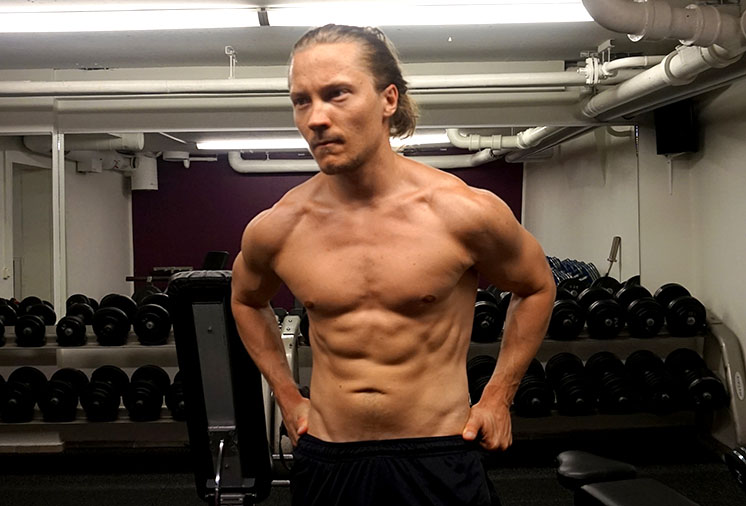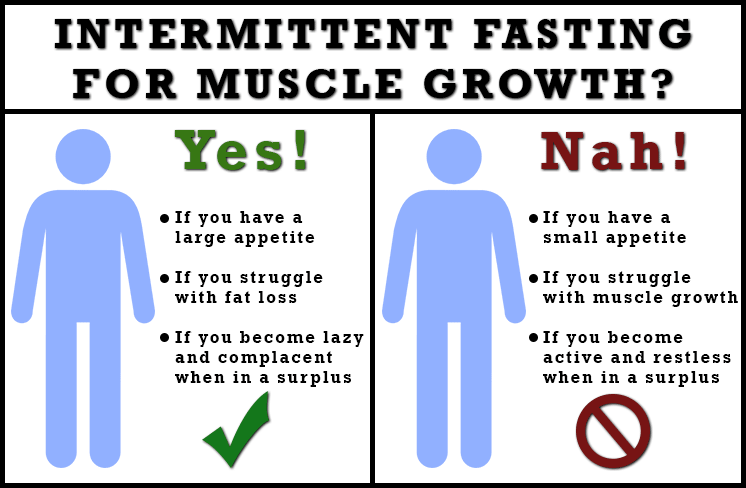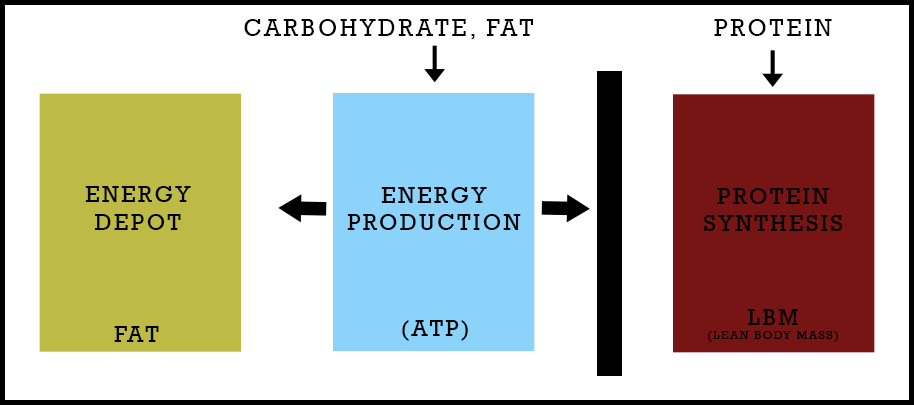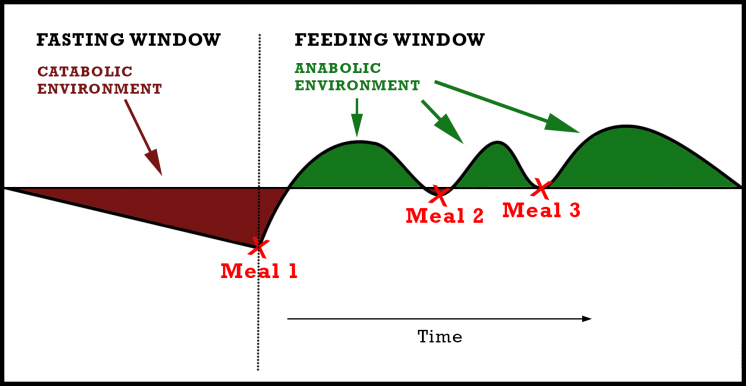
Do you agree with me when I say:
Staying lean when trying to build muscle is hard?
Well, if that’s the case here’s some good news:
You can dramatically improve your ability to stay lean when building muscle by utilizing the awesome tool of intermittent fasting.
And in today’s post (and video) I’m going to show you the benefits of using intermittent fasting for muscle growth, and also cover the potential drawbacks as well.
Let’s go!
Table of Contents
Why I’m Using Intermittent Fasting Even When I’m Bulking
If you’ve been following me for a while, you know that I love intermittent fasting. Especially when cutting, since it makes fat loss feel basically effortless:
But, what about for bulking?
Well, I’m still using intermittent fasting when bulking as well, as it helps me stay lean easier.
And it do so in the following three ways:
- By providing a smooth transition between cutting and bulking
- By making it harder to overeat.
- By improving nutrient partitioning slightly
Let’s look at these one by one:
1. Smooth Transition Between Cutting And Bulking
Here’s the thing:
If you utilize intermittent fasting when cutting, then your body gets used to that eating pattern.
This means that, if want to gain muscle without gaining fat when bulking, you should keep your eating pattern pretty much the same when you start bulking as well.
Why?
Well, if you break the fasting pattern, you could potentially add a lot of extra calories at the times you previously used to fast. While your body will still be hungry during the times you used to eat.
Here’s an example:
Let’s say you maintain your weight at 2800 calories per day once your cut is over. Let’s also say that as you transition into bulking, you set up your daily caloric surplus to be 100 calories above maintenance. This intake should, in this example, lead to muscle growth with minimal fat storage.
Now, if you continue to use intermittent fasting, then eating 2900 calories per day makes you feel satiated and full, which means you slowly gain mostly muscle.
But suddenly you start adding breakfast again (or whichever meal you used to skip), let’s say this meal contains 500 calories.
What will likely happen is that your body still wants the 2900 calories during your old “feeding window”, while you also have the 500 calories in your old “fasting window”.
You see, your daily caloric intake will now be 3400, which is way too large to support only muscle growth, and you will start accumulating fat…
But, now you might wonder, won’t I adapt to eating more often?
Look:
Usually the body is pretty good at regulating appetite.
Meaning, if you start eating more at one time of the day, you will become less hungry during other parts of the day.
However, this doesn’t happen immediately once you change from a certain feeding pattern that you’ve been using for a while.
No, some time will be needed for the body to get used to eating more often.
Also, after a cut, your appetite will be higher than what it normally is. Because, if you lost a fair amount of weight, chances are your body haven’t fully adapted to a lower body fat percentage yet.
And when you lose the structure of buffering food to a “feeding window”, rapid fat gain can quickly become an issue…
finally, the last reason for keeping your intermittent fasting schedule as you transition into bulking, is so that you can easier avoid fat gain caused by getting a bit complacent.
This is very normal, especially if you start out with the skinny fat or fat physiques:
In fact, something that typically happens for me once I’m done cutting, is that I start to tell myself things like:
“I can indulge in this and that, now that I’m bulking”
Or:
“I’ve been so good during my cut, I’m worthy of a 1500 calorie breakfast, lunch and dinner”
And these things are nothing but stories that pops up in our minds when we’re becoming complacent.
So, if you want to reduce the risk of overeating when trying to build muscle because of increased appetite and/or complacency, then intermittent fasting will definitely help.
And here’s how:
2. Intermittent Fasting Makes it Harder to Overeat
The main thing that makes intermittent fasting so powerful for appetite control, is that it allows you to buffer calories for later in the day, by eating less earlier in the day.
It’s been shown that fasting for a prolonged period of time reduces hunger during the fast in and of itself, especially with the help of these 8 tricks.
This mainly happens via elevations of various stress hormones.
Not only does this physiological process blunt appetite during your fasted window, it also helps with fat mobilization and fat burning as well.
This is the reason why intermittent fasting is so powerful when cutting. Because you can have extremely large meals during the second part of the day, while blunting hunger during the first part of the day.
But, isn’t this a muscle building post?!
Yes, and here’s the deal:
It works exactly the same for building muscle as well, the only difference is that you eat in a slight surplus of calories with the goal to maximize muscle growth.
And the power of intermittent fasting is that it helps keeping the surplus slight.
Is Intermittent Fasting For Muscle Growth Right For You?

For people who naturally have a big appetite, using intermittent fasting to improve satiation helps immensely with staying lean while focusing on muscle growth. This is exactly what it did for me when I started out. I was skinny fat with a huge appetite and IF helped me immensely!
But, on the other hand, intermittent fasting doesn’t make that much sense for individuals who don’t have a big appetite, or who experiences weight gain to be challenging.
Simply because it will be even harder for these individuals to eat enough food required to be in a calorie surplus.
So, if that’s you, perhaps you would do better eating more often instead, so you can get more food in easier.
But, if your appetite is crazy, then using intermittent fasting will be beneficial.
Not only that, you will also take advantage of:
3. Slightly Improved Nutrient Partitioning
Okay so now you might wonder:
“What the heck is nutrient partitioning?”
Well, let me explain:
Each time we consume food the nutrients provided must go somewhere.
And nutrient partitioning explains the ratios of where the body store these nutrients.
In other words, will the nutrients you eat be used to repair and build muscles, tendons and ligaments etc? Or will they be stored as body fat or glycogen?

Obviously, you want as much of the surplus as possible to go towards repair, muscle growth and glycogen storage, and not fat storage.
And here’s the good news:
Research shows that intermittent fasting can cause slightly better nutrient partitioning if combined with resistance training.
This means that relatively speaking, more of the nutrients you eat will be used for repair and muscle growth than what they would if you didn’t fast.
And here’s how:
After your body’s been in a prolonged period of catabolism (fasting), the sensitivity of different hormones gets up-regulated in your muscles.
In other words, your muscles get extremely hungry!
For example:
Your muscles insulin sensitivity goes through the roof, and so does your intramuscular lipid stores sensitivity.
This will cause more of the upcoming nutrients you ingest to be stored in your muscles and not as fat.
Furthermore, this paper shows that you can get something called a compensatory response effect from doing resistance training in conjunction with intermittent fasting.
This basically means that the potential muscle growth that you miss out on during your fasted window, will be supercompensated for once you’re in your feeding window.
And here’s what you can do to take advantage of this:
Strategically Place Your Training to Optimize Your Nutrient Partitioning
Essentially what happens when you use intermittent fasting is this:

As you can see, first you create a large catabolic environment in your body during your fasted window. Then as you start eating, you create a large anabolic environment instead.
And here’s where it gets interesting:
If you place your training either right before your feeding window or somewhere in it, more of the nutrients you eat during your feeding window will go towards muscle growth.
By doing this you provide your body with nutrients only during times when you’re muscle building process is mostly activated.
This means that the majority of nutrients you eat will go towards repairing and building new muscle tissue instead of being stored as body fat!
Now, I’m not saying that your entire calorie surplus will go towards muscle growth, but a larger portion of it might.
I’m emphasizing might because research isn’t completely clear if this really is the case. More data must be available before making any definite assumptions.
However, it’s still a cool benefit and even if the partitioning effects are small, it might still make a significant difference seen over years of training.
And if eventually we’ll learn that intermittent fasting don’t have any positive effects on nutrient partitioning, at least it remains a valid tool for appetite control!
Okay so before finishing up this post, let’s answer the million dollar question regarding intermittent fasting and muscle growth.
Which is:
Can You Maximize Your Muscle Building Potential When You’re Using Intermittent Fasting?
One common concern people have when it comes to intermittent fasting, is if it’s possible to maximize muscle growth.
The worry is that; since you fast for so many hours straight, you also spend a lot of time in a catabolic state, where the muscle protein synthesis can’t be maximized.
So, what’s the deal? Can you actually maximize muscle growth with intermittent fasting?
Well here’s the truth:
So, it seems that eating protein more frequently than just during a 6-8 hour feeding window is required to maximize muscle growth.
The Difference on Muscle Growth Between More & Less Frequent Protein Feedings Are Small
As long as you’re not taking fasting to the extremes, (such as eating only one big meal per day), then the difference on muscle growth is very small.
This is because by eating a few (3-4) larger meals with more protein, you will also have food in your belly for longer. Meaning, muscle protein synthesis can be maximized for longer as well.
Not only that, the supercompensation effect that I talked about earlier, will likely make up for the reduced daily muscle protein synthesis seen in the Norton study. Maybe not completely, but at least a bit.
I wrote more about how often you should eat to build muscle in this post. But, the tldr is that meal frequency and timing is FAR less important than eating the right total amount of energy and nutrients during a day when it comes muscle growth.
Practical Implementations
From looking at the work done by Martin Berkhan over at leangains.com, it seems that 16 hours is the optimal length of the fasting window if your goal is to keep building muscle effectively.
And it also looks like, as long as you’re getting in at least three rather evenly spread boluses of protein during your feeding window, then you can get very similar results on muscle growth to what you would with a more standard meal frequency.
This also demonstrates the clear order of importance when it comes to dieting for muscle growth.
Where meal frequency is placed fourth in the hierarchy, and that overall calories, macronutrients and micronutrients are way more important than when we choose to eat them.
Finally, if you don’t trust fasting when it comes to building muscle, but you still want the appetite reducing effects. Then you can take another approach.
Which is this one:
Eat 20-40 grams of lean protein during your “fasted” window and save the remaining macros for later in the day.
This way you will get pretty much the same appetite reducing effects, but you will also maximize muscle growth.
Creating a win, win situation!
My own thoughts on intermittent fasting for muscle growth
Let’s say that by utilizing intermittent fasting you must work one year longer before you reach your genetic muscular potential, than what you would if you didn’t fast.
But, during this time you can stay lean easier, which means less cutting, while also being able to indulge in big and satiating meals.
Personally, I would say that it’s worth staying slightly behind in muscular development in order to get these benefits.
And my guess is that you won’t be that much behind anyways, since you’ll probably take on less cutting phases by staying more lean year round. And we all know that a prolonged caloric deficit is definitely the largest inhibitor of muscle growth.
What’s Next?
Okay, so intermittent fasting can help you stay lean more easily when bulking, which is truly awesome! The next step would be to set up, what I believe to be the best IF schedule, which I call “Flexible Fasting”, you can read more about setting it up here!
